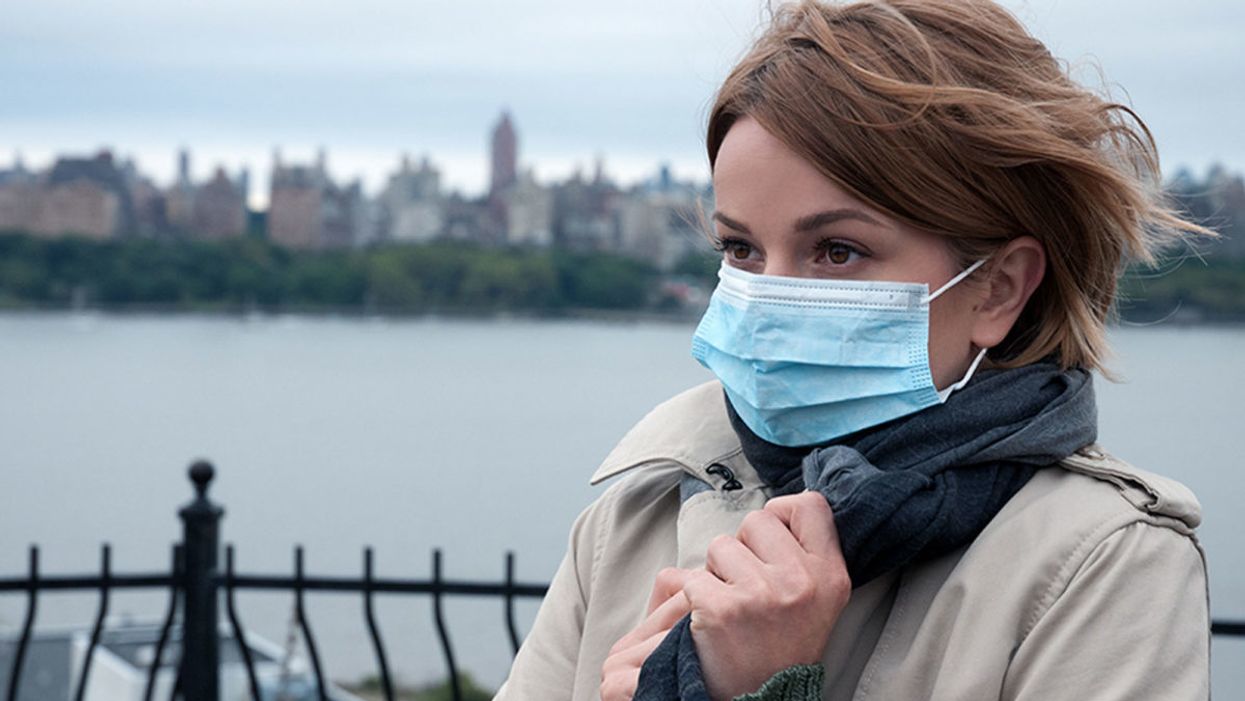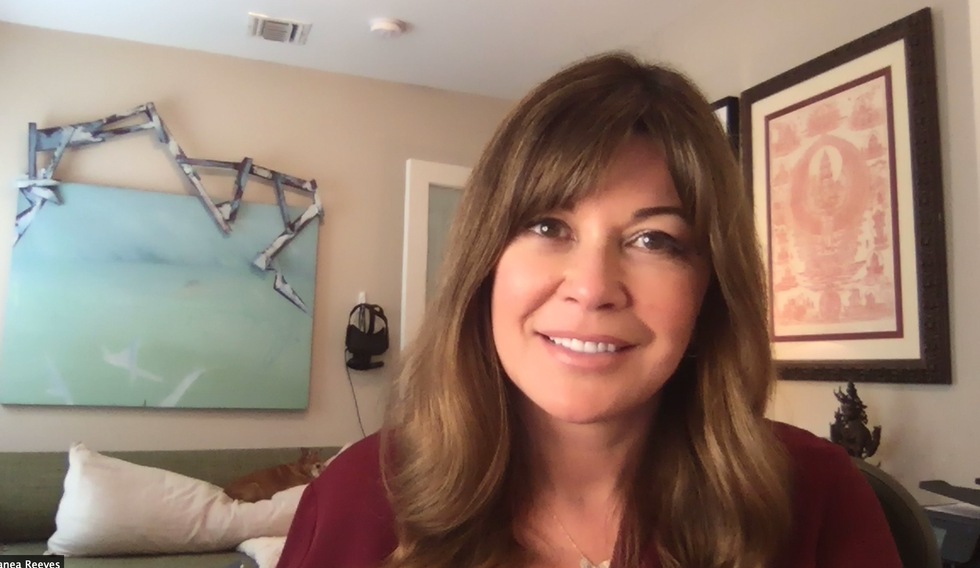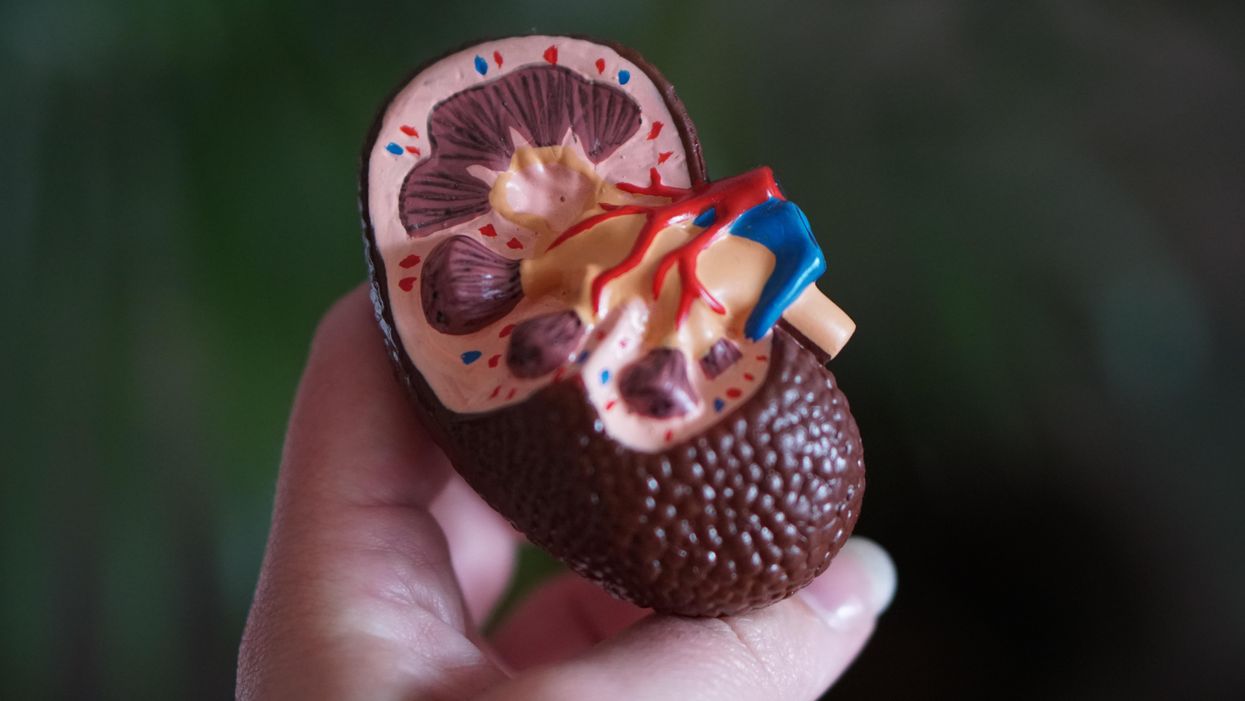Scientists Are Building an “AccuWeather” for Germs to Predict Your Risk of Getting the Flu

A future app may help you avoid getting the flu by informing you of your local risk on a given day.
Applied mathematician Sara del Valle works at the U.S.'s foremost nuclear weapons lab: Los Alamos. Once colloquially called Atomic City, it's a hidden place 45 minutes into the mountains northwest of Santa Fe. Here, engineers developed the first atomic bomb.
Like AccuWeather, an app for disease prediction could help people alter their behavior to live better lives.
Today, Los Alamos still a small science town, though no longer a secret, nor in the business of building new bombs. Instead, it's tasked with, among other things, keeping the stockpile of nuclear weapons safe and stable: not exploding when they're not supposed to (yes, please) and exploding if someone presses that red button (please, no).
Del Valle, though, doesn't work on any of that. Los Alamos is also interested in other kinds of booms—like the explosion of a contagious disease that could take down a city. Predicting (and, ideally, preventing) such epidemics is del Valle's passion. She hopes to develop an app that's like AccuWeather for germs: It would tell you your chance of getting the flu, or dengue or Zika, in your city on a given day. And like AccuWeather, it could help people alter their behavior to live better lives, whether that means staying home on a snowy morning or washing their hands on a sickness-heavy commute.

Sara del Valle of Los Alamos is working to predict and prevent epidemics using data and machine learning.
Since the beginning of del Valle's career, she's been driven by one thing: using data and predictions to help people behave practically around pathogens. As a kid, she'd always been good at math, but when she found out she could use it to capture the tentacular spread of disease, and not just manipulate abstractions, she was hooked.
When she made her way to Los Alamos, she started looking at what people were doing during outbreaks. Using social media like Twitter, Google search data, and Wikipedia, the team started to sift for trends. Were people talking about hygiene, like hand-washing? Or about being sick? Were they Googling information about mosquitoes? Searching Wikipedia for symptoms? And how did those things correlate with the spread of disease?
It was a new, faster way to think about how pathogens propagate in the real world. Usually, there's a 10- to 14-day lag in the U.S. between when doctors tap numbers into spreadsheets and when that information becomes public. By then, the world has moved on, and so has the disease—to other villages, other victims.
"We found there was a correlation between actual flu incidents in a community and the number of searches online and the number of tweets online," says del Valle. That was when she first let herself dream about a real-time forecast, not a 10-days-later backcast. Del Valle's group—computer scientists, mathematicians, statisticians, economists, public health professionals, epidemiologists, satellite analysis experts—has continued to work on the problem ever since their first Twitter parsing, in 2011.
They've had their share of outbreaks to track. Looking back at the 2009 swine flu pandemic, they saw people buying face masks and paying attention to the cleanliness of their hands. "People were talking about whether or not they needed to cancel their vacation," she says, and also whether pork products—which have nothing to do with swine flu—were safe to buy.
At the latest meeting with all the prediction groups, del Valle's flu models took first and second place.
They watched internet conversations during the measles outbreak in California. "There's a lot of online discussion about anti-vax sentiment, and people trying to convince people to vaccinate children and vice versa," she says.
Today, they work on predicting the spread of Zika, Chikungunya, and dengue fever, as well as the plain old flu. And according to the CDC, that latter effort is going well.
Since 2015, the CDC has run the Epidemic Prediction Initiative, a competition in which teams like de Valle's submit weekly predictions of how raging the flu will be in particular locations, along with other ailments occasionally. Michael Johannson is co-founder and leader of the program, which began with the Dengue Forecasting Project. Its goal, he says, was to predict when dengue cases would blow up, when previously an area just had a low-level baseline of sick people. "You'll get this massive epidemic where all of a sudden, instead of 3,000 to 4,000 cases, you have 20,000 cases," he says. "They kind of come out of nowhere."
But the "kind of" is key: The outbreaks surely come out of somewhere and, if scientists applied research and data the right way, they could forecast the upswing and perhaps dodge a bomb before it hit big-time. Questions about how big, when, and where are also key to the flu.
A big part of these projects is the CDC giving the right researchers access to the right information, and the structure to both forecast useful public-health outcomes and to compare how well the models are doing. The extra information has been great for the Los Alamos effort. "We don't have to call departments and beg for data," says del Valle.
When data isn't available, "proxies"—things like symptom searches, tweets about empty offices, satellite images showing a green, wet, mosquito-friendly landscape—are helpful: You don't have to rely on anyone's health department.
At the latest meeting with all the prediction groups, del Valle's flu models took first and second place. But del Valle wants more than weekly numbers on a government website; she wants that weather-app-inspired fortune-teller, incorporating the many diseases you could get today, standing right where you are. "That's our dream," she says.

This plot shows the the correlations between the online data stream, from Wikipedia, and various infectious diseases in different countries. The results of del Valle's predictive models are shown in brown, while the actual number of cases or illness rates are shown in blue.
(Courtesy del Valle)
The goal isn't to turn you into a germophobic agoraphobe. It's to make you more aware when you do go out. "If you know it's going to rain today, you're more likely to bring an umbrella," del Valle says. "When you go on vacation, you always look at the weather and make sure you bring the appropriate clothing. If you do the same thing for diseases, you think, 'There's Zika spreading in Sao Paulo, so maybe I should bring even more mosquito repellent and bring more long sleeves and pants.'"
They're not there yet (don't hold your breath, but do stop touching your mouth). She estimates it's at least a decade away, but advances in machine learning could accelerate that hypothetical timeline. "We're doing baby steps," says del Valle, starting with the flu in the U.S., dengue in Brazil, and other efforts in Colombia, Ecuador, and Canada. "Going from there to forecasting all diseases around the globe is a long way," she says.
But even AccuWeather started small: One man began predicting weather for a utility company, then helping ski resorts optimize their snowmaking. His influence snowballed, and now private forecasting apps, including AccuWeather's, populate phones across the planet. The company's progression hasn't been without controversy—privacy incursions, inaccuracy of long-term forecasts, fights with the government—but it has continued, for better and for worse.
Disease apps, perhaps spun out of a small, unlikely team at a nuclear-weapons lab, could grow and breed in a similar way. And both the controversies and public-health benefits that may someday spin out of them lie in the future, impossible to predict with certainty.
When Willem Johan Kolff invented dialysis, the "father" of artificial organs was just getting started.
One of the Netherlands’ most famous pieces of pop culture is “Soldier of Orange.” It’s the title of the country’s most celebrated war memoir, movie and epic stage musical, all of which detail the exploits of the nation’s resistance fighters during World War II.
Willem Johan Kolff was a member of the Dutch resistance, but he doesn’t rate a mention in the “Solider of Orange” canon. Yet his wartime toils in a rural backwater not only changed medicine, but the world.
Kolff had been a physician less than two years before Germany invaded the Netherlands in May 1940. He had been engaged in post-graduate studies at the University of Gronigen but withdrew because he refused to accommodate the demands of the Nazi occupiers. Kolff’s Jewish supervisor made an even starker choice: He committed suicide.
After his departure from the university, Kolff took a job managing a small hospital in Kampen. Located 50 miles from the heavily populated coastal region, the facility was far enough away from the prying eyes of Germans that not only could Kolff care for patients, he could hide fellow resistance fighters and even Jewish refugees in relative safety. Kolff coached many of them to feign convincing terminal illnesses so the Nazis would allow them to remain in the hospital.
Despite the demands of practicing medicine and resistance work, Kolff still found time to conduct research. He had been haunted and inspired when, not long before the Nazi invasion, one of his patients died in agony from kidney disease. Kolff wanted to find a way to save future patients.
He broke his problem down to a simple task: If he could remove 20 grams of urea from a patient’s blood in 24 hours, they would survive. He began experimenting with ways to filter blood and return it to a patient’s body. Since the war had ground all non-military manufacturing to a halt, he was mostly forced to make do with material he could find at the hospital and around Kampen. Kolff eventually built a device from a washing machine parts, juice cans, sausage casings, a valve from an old Ford automobile radiator, and even scrap from a downed German aircraft.
The world’s first dialysis machine was hardly imposing; it resembled a rotating drum for a bingo game or raffle. Yet it carried on the highly sophisticated task of moving a patient’s blood through a semi-permeable membrane (about a 50-foot length of sausage casings) into a saline solution that drew out urea while leaving the blood cells untouched.
In emigrating to the U.S. to practice medicine, Kolff's intent was twofold: Advocate for a wider adoption of dialysis, and work on new projects. He wildly succeeded at both.
Kolff began using the machine to treat patients in 1943, most of whom had lapsed into comas due to their kidney failure. But like most groundbreaking medical devices, it was not an immediate success. By the end of the war, Kolff had dialyzed more than a dozen patients, but all had died. He briefly suspended use of the device after the Allied invasion of Europe, but he continued to refine its operation and the administration of blood thinners to patients.
In September 1945, Kolff dialyzed another comatose patient, 67-year-old Sofia Maria Schafstadt. She regained consciousness after 11 hours, and would live well into the 1950s with Kolff’s assistance. Yet this triumph contained a dark irony: At the time of her treatment, Schafstadt had been imprisoned for collaborating with the Germans.
With a tattered Europe struggling to overcome the destruction of the war, Kolff and his family emigrated to the U.S. in 1950, where he began working for the Cleveland Clinic while undergoing the naturalization process so he could practice medicine in the U.S. His intent was twofold: Advocate for a wider adoption of dialysis, and work on new projects. He wildly succeeded at both.
By the mid-1950s, dialysis machines had become reliable and life-saving medical devices, and Kolff had become a U.S. citizen. About that time he invented a membrane oxygenator that could be used in heart bypass surgeries. This was a critical component of the heart-lung machine, which would make heart transplants possible and bypass surgeries routine. He also invented among the very first practical artificial hearts, which in 1957 kept a dog alive for 90 minutes.
Kolff moved to the University of Utah in 1967 to become director of its Institute for Biomedical Engineering. It was a promising time for such a move, as the first successful transplant of a donor heart to a human occurred that year. But he was interested in going a step further and creating an artificial heart for human use.
It took more than a decade of tinkering and research, but in 1982, a team of physicians and engineers led by Kolff succeeded in implanting the first artificial heart in dentist Barney Clark, whose failing health disqualified him from a heart transplant. Although Clark died in March 1983 after 112 days tethered to the device, that it kept him alive generated international headlines. While graduate student Robert Jarvik received the named credit for the heart, he was directly supervised by Kolff, whose various endeavors into artificial organ research at the University of Utah were segmented into numerous teams.
Forty years later, several artificial hearts have been approved for use by the Food and Drug Administration, although all are a “bridge” that allow patients to wait for a transplant.
Kolff continued researching and tinkering with biomedical devices – including artificial eyes and ears – until he retired in 1997 at the age of 86. When he died in 2009, the medical community acknowledged that he was not only a pioneer in biotechnology, but the “father” of artificial organs.
An image from one of TRIPP's virtual reality experiences for mental wellness. Nanea Reeves is TRIPP's CEO.
The "Making Sense of Science" podcast features interviews with leading experts about health innovations and the ethical questions they raise. The podcast is hosted by Matt Fuchs, editor of Leaps.org, the award-winning science outlet.
My guest today is Nanea Reeves, the CEO of TRIPP, a wellness platform with some big differences from meditation apps you may have tried like Calm and Headspace. TRIPP's experiences happen in virtual reality, and its realms are designed based on scientific findings about states of mindfulness. Users report feelings of awe and wonder and even mystical experiences. Nanea brings over 15 years of leadership in digital distribution, apps and video game technologies. Before co-founding TRIPP, she had several other leadership roles in tech with successful companies like textPlus and Machinima. Read her full bio below in the links section.

Nanea Reeves, CEO of TRIPP.
TRIPP
Listen to the Episode
Listen on Apple | Listen on Spotify | Listen on Stitcher | Listen on Amazon | Listen on Google
This conversation coincided with National Brain Awareness Week. The topic is a little different from the Making Sense of Science podcast’s usual focus on breakthroughs in treating and preventing disease, but there’s a big overlap when it comes to breakthroughs in optimal health. Nanea’s work is at the leading edge of health, technology and the science of wellness.
With TRIPP, you might find yourself deep underwater, looking up at the sunlight shimmering on the ocean surface, or in the cosmos staring down at a planet glowing with an arresting diversity of colors. Using TRIPP for the past six months has been a window for me into the future of science-informed wellness and an overall fascinating experience, as was my conversation with Nanea.
Show notes:
Nanea and I discuss her close family members' substance addictions and her own struggle with mental illness as a teen, which led to her first meditation experiences, and much more:
- The common perception that technology is an obstacle for mental well-being, a narrative that overlooks how tech can also increase wellness when it’s designed right.
- Emerging ways of measuring meditation experiences by recording brain waves - and the shortcomings of the ‘measured self’ movement.
- Why TRIPP’s users multiplied during the stress and anxiety of the pandemic, and how TRIPP can can be used to enhance emotional states.
- Ways in which TRIPP’s visuals and targeted sound frequencies have been informed by innovative research from psychologists like Johns Hopkins’ Matthew Johnson.
- Ways to design apps and other technologies to better fulfill the true purpose of mindfulness meditation. (Hint: not simply relaxation.)
- And of course, because the topic is mental wellness and tech, I had to get Nanea's thoughts on Elon Musk, Neuralink and brain machine interfaces.
Here are links for learning more about TRIPP:
- TRIPP website: https://www.tripp.com/about/
- Nanea Reeves bio: https://www.tripp.com/team/nanea-reeves/
- Study of data collected by UK's Office for National Statistics on behavior during the pandemic, which suggests that TRIPP enhanced users' psychological and emotional mindsets: https://link.springer.com/chapter/10.1007/978-3-03...
- Research that's informed TRIPP: https://www.tripp.com/research/
- Washington Post Top Pick at CES: https://www.washingtonpost.com/technology/2019/01/...
- TRIPP's new offering, PsyAssist, to provide support for ketamine-assisted therapy: https://www.mobihealthnews.com/news/tripp-acquires...
- Randomized pilot trial involving TRIPP: https://bmjopen.bmj.com/content/bmjopen/11/4/e0441...

